
Faience or faïence is the general English language term for fine tin-glazed pottery. The invention of a white pottery glaze suitable for painted decoration, by the addition of an oxide of tin to the slip of a lead glaze, was a major advance in the history of pottery. The invention seems to have been made in Iran or the Middle East before the ninth century. A kiln capable of producing temperatures exceeding 1,000 °C (1,830 °F) was required to achieve this result, the result of millennia of refined pottery-making traditions. The term is now used for a wide variety of pottery from several parts of the world, including many types of European painted wares, often produced as cheaper versions of porcelain styles.

Goldscheider Porcelain Manufactory and Majolica Factory was an Austrian ceramic manufactory.

The Nymphenburg Palace is a Baroque palace situated in Munich's western district Neuhausen-Nymphenburg, in Bavaria, southern Germany. The Nymphenburg served as the main summer residence for the former rulers of Bavaria of the House of Wittelsbach. Combined with the adjacent Nymphenburg Palace Park it constitutes one of the premier royal palaces of Europe. Its frontal width of 632 m (2,073 ft) even surpasses Versailles.

A tureen is a serving dish for foods such as soups or stews, often shaped as a broad, deep, oval vessel with fixed handles and a low domed cover with a knob or handle. Over the centuries, tureens have appeared in many different forms: round, rectangular, or made into fanciful shapes such as animals or wildfowl. Tureens may be ceramic—either the glazed earthenware called faience, or porcelain—or silver, and customarily they stand on an undertray or platter made en suite.
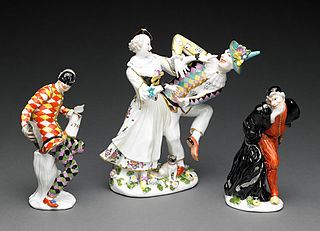
Meissen porcelain or Meissen china was the first European hard-paste porcelain. Early experiments were done in 1708 by Ehrenfried Walther von Tschirnhaus. After his death that October, Johann Friedrich Böttger continued von Tschirnhaus's work and brought this type of porcelain to the market, financed by Augustus the Strong, King of Poland and Elector of Saxony. The production of porcelain in the royal factory at Meissen, near Dresden, started in 1710 and attracted artists and artisans to establish, arguably, the most famous porcelain manufacturer known throughout the world. Its signature logo, the crossed swords, was introduced in 1720 to protect its production; the mark of the swords is reportedly one of the oldest trademarks in existence.

The Bavarian National Museum in Munich is one of the most important museums of decorative arts in Europe and one of the largest art museums in Germany. Since the beginning the collection has been divided into two main groups: the art historical collection and the folklore collection.

The Nymphenburg Porcelain Manufactory is located at the Nördliches Schloßrondell in one of the Cavalier Houses in front of the Nymphenburg Palace in Munich, Germany, and since its establishment in 1747 has produced porcelain of high quality. It is one of the last porcelain producers in the world where every single part is made entirely by hand.
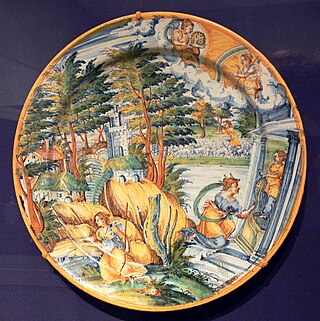
Tin-glazed pottery is earthenware covered in lead glaze with added tin oxide which is white, shiny and opaque ; usually this provides a background for brightly painted decoration. It has been important in Islamic and European pottery, but very little used in East Asia. The pottery body is usually made of red or buff-colored earthenware and the white glaze imitated Chinese porcelain. The decoration on tin-glazed pottery is usually applied to the unfired glaze surface by brush with metallic oxides, commonly cobalt oxide, copper oxide, iron oxide, manganese dioxide and antimony oxide. The makers of Italian tin-glazed pottery from the late Renaissance blended oxides to produce detailed and realistic polychrome paintings.

The Vienna Porcelain Manufactory Augarten is a porcelain manufactory located in Vienna, Austria. It was founded in 1718 and is one of the oldest porcelain manufacturers in Europe. The Vienna Porcelain Manufactory Augarten is also home to the Augarten Porcelain Museum, which displays a collection of historic and contemporary porcelain pieces. In addition to its porcelain products, the company also produces glassware, cutlery, and other home accessories.
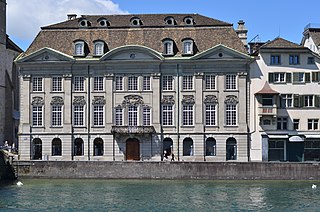
The Zunfthaus zur Meisen is the guild house of the Zunft zur Meisen. It is one of the many historically valuable buildings in the Lindenhof quarter in Zürich, Switzerland, and also housed the porcelain and faience collection of the Swiss National Museum by April 2018. It is situated at the Münsterhof and the Münsterbrücke, a bridge over the river Limmat, opposite the upper Limmatquai with the Constaffel, Zimmerleuten, Kämbel and Saffran guild houses.

The Historical Museum of Bamberg is a museum in Bamberg, Germany, located in the Alte Hofhaltung next to the city's cathedral. Together with the Villa Dessauer and the Collection Ludwig, a collection of porcelain and faience, it belongs to the museums of the city.

Mennecy-Villeroy porcelain is a French soft-paste porcelain from the manufactory established under the patronage of Louis-François-Anne de Neufville, duc de Villeroy (1695–1766) and — from 1748 — housed in outbuildings in the park of his château de Villeroy, and in the nearby village of Mennecy (Île-de-France). The history of the factory remains somewhat unclear, but it is typically regarded as producing between about 1738 and 1765.

The city of Rouen, Normandy has been a centre for the production of faience or tin-glazed earthenware pottery, since at least the 1540s. Unlike Nevers faience, where the earliest potters were immigrants from Italy, who at first continued to make wares in Italian maiolica styles with Italian methods, Rouen faience was essentially French in inspiration, though later influenced by East Asian porcelain. As at Nevers, a number of styles were developed and several were made at the same periods.

French porcelain has a history spanning a period from the 17th century to the present. The French were heavily involved in the early European efforts to discover the secrets of making the hard-paste porcelain known from Chinese and Japanese export porcelain. They succeeded in developing soft-paste porcelain, but Meissen porcelain was the first to make true hard-paste, around 1710, and the French took over 50 years to catch up with Meissen and the other German factories.

Rouen porcelain is soft-paste porcelain made in the city of Rouen, Normandy, France, during a brief period from about 1673 to 1696. It was the earliest French porcelain, but was probably never made on a commercial basis; only nine pieces are now thought to survive.

The Royal Porcelain Factory in Berlin, also known as the Royal Porcelain Manufactory Berlin and whose products are generally called Berlin porcelain, was founded in 1763 by King Frederick II of Prussia. Its actual origins, however, lie in three private enterprises which, under crown patronage, were trying to establish the production of "white gold" in Berlin from the mid-18th century onwards.

Niderviller faience is one of the most famous French pottery manufacturers. It has been located in the village of Niderviller, Lorraine, France since 1735. It began as a maker of faïence, and returned to making this after a period in the mid-18th century when it also made hard-paste porcelain. In both materials, it made heavy use of deep magenta or pink in its decoration.
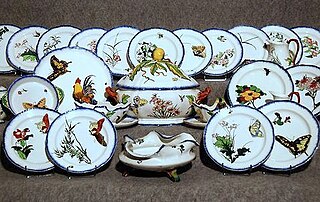
Creil-Montereau faience is a faïence fine, a lead-glazed earthenware on a white body originating in the French communes of Creil, Oise and of Montereau, Seine-et-Marne, but carried forward under a unified direction since 1819. Emulating the creamware perfected by Josiah Wedgwood in the 1770s, and under the artistic and technical direction of native English potter entrepreneurs, the faience of Creil-Montereau introduced the industrial technique of transfer printing on pottery in France and raised it to a high state of perfection during its peak years in the 19th century.
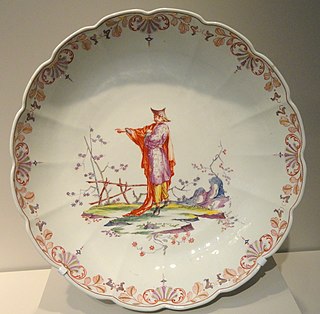
Vienna porcelain is the product of the Vienna Porcelain Manufactory, a porcelain manufacturer in Alsergrund in Vienna, Austria. It was founded in 1718 and continued until 1864.

Ludwigsburg porcelain is porcelain made at the Ludwigsburg Porcelain Manufactory founded by Charles Eugene, Duke of Württemberg, on 5 April 1758 by decree as the Herzoglich-ächte Porcelaine-Fabrique. It operated from the grounds of the Baroque Ludwigsburg Palace. After a first two decades that were artistically, but not financially, successful, the factory went into a slow decline and was closed in 1824. Much later a series of other companies used the Ludwigsburg name, but the last production was in 2010.



















